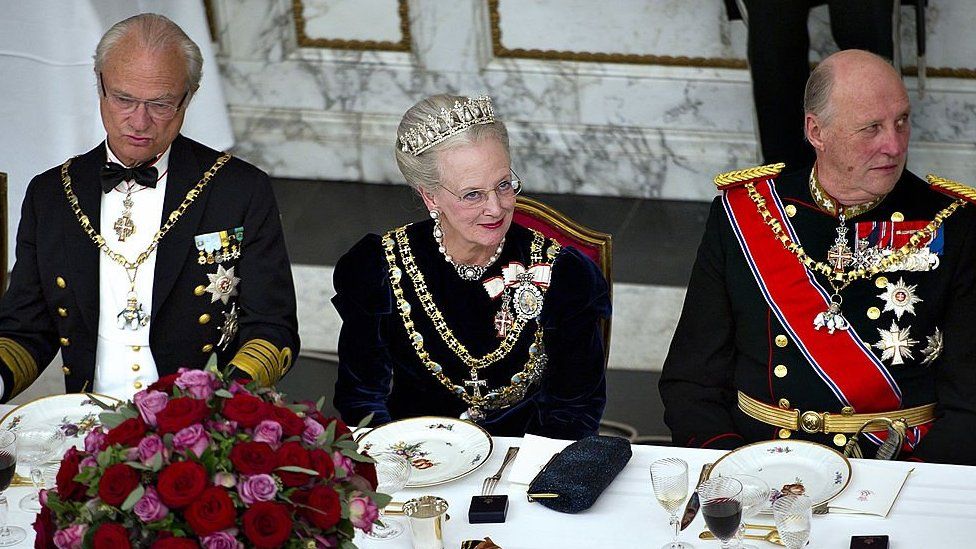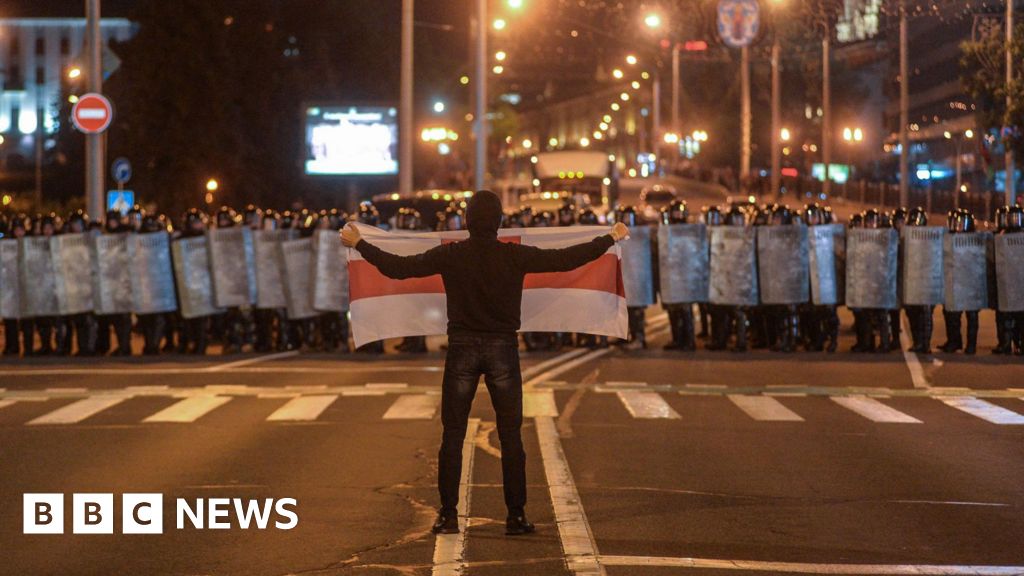ARTICLE AD BOX
 Image source, Getty Images
Image source, Getty Images
King Carl XVl Gustaf of Sweden, Queen Margrethe ll of Denmark and King Harald V of Norway celebrate Margrethe's 40th jubilee in 2012
When Queen Margrethe II of Denmark steps down on Sunday, many Danes will be bereft.
Now that she is abdicating in favour of Crown Prince Frederik, 55, the question is whether she has broken a taboo for all three Nordic royal families.
Denmark's chain-smoking, flamboyant, polyglot Danish queen - who Prime Minister Mette Frederiksen described as the "epitome of Denmark" - spent more than half a century on the throne. Danes have been proud of her quirks, her outspoken rejection of mobile phones and the internet, and her relaxed and playful air.
Margrethe's approachability is typical of the royal houses of Denmark, Sweden and Norway, whose informal manner has earned them high approval ratings as well as the nickname of "bicycling monarchies" - perhaps a nod to a favourite pastime of many northern Europeans, but also a way of setting the Nordic hereditary kingdoms apart from stuffier counterparts.
Younger royals have cemented this impression. Danish Crown Prince Frederik is seen as a friendly, down-to-earth family man with a penchant for rock music; Haakon, the heir to the Norwegian throne, has built a reputation for pranks at gala dinners; and Sweden's beloved Crown Princess Victoria has been open about her struggles with anorexia.
Many Danish and Norwegian royals also send their children to public schools - and it helps that the three heirs to the Nordic thrones have all married commoners.
The affinity between the members of the three royal families is plain to see: they often visit one another, and some even go on holiday together. It's also worth noting that the three current monarchs are all related: Norway's King Harald V and Sweden's Carl XVI Gustaf are Margrethe's second and first cousins respectively.
Image source, Getty Images
Image caption,Queen Margrethe will step down from the Danish throne on 14 January - 52 years to the day since she became queen
"Nordic monarchies share the same values, culture, history. Their royals are all widely seen as hard-working and keen to talk to people and to engage with them," royal commentator Marie Ronde for Denmark's TV2 told the BBC.
Monarchs in the three Nordic royal families have also been able to keep up with changing times.
In the late 1970s, Carl XVI Gustaf changed Swedish law to ensure his eldest daughter could succeed him, rather than his only son. He has also been a lifelong champion of environmentalism, and has often used his position to raise awareness on climate change.
Harald has been known to hold similarly progressive views. In 2016, he made an impassioned speech in support of LGBT equality and refugees, paying tribute to his fellow citizens from "Afghanistan, Pakistan and Poland, from Sweden, Somalia, and Syria," and saying that Norwegians "are girls who love girls, boys who love boys, and girls and boys who love each other".
Above all, Nordic monarchies have proved they are capable of more than just cosmetic changes - most notably by choosing to slim down their monarchies.
In 2019, Carl XVI Gustaf removed five of his grandchildren from the royal house, reflecting a wider view that there is no need to pay so many members of the royal family for official duties.
Three years later, Margrethe stripped four of her grandchildren of their royal titles - something she said would "future-proof" the institution and allow it to "keep with the times".
These decisions have paid off. Approval rates for the Danish and Norwegian regents consistently hover around the 80% mark, while a recent Swedish poll showed that anti-monarchy sentiment was at its lowest in over 20 years.
Abdication, then, remains the last hurdle. Despite negative connotations in some quarters, it is not a universally reviled practice among Europe's royal families.
In the Netherlands it has become something of a tradition: four Dutch monarchs have decided to step down in favour of their children since the Netherlands became an independent monarchy in 1815, and several grand dukes of neighbouring Luxembourg have also relinquished the throne to their heirs with apparent ease.
Image source, Getty Images
Image caption,King Harald V of Norway, Queen Margrethe II of Denmark and Queen Sonja of Norway at the World Nordic Ski Championships in 2011
It's true that, in many places, the concept conjures up unpleasant memories. The former kings of Spain and the Belgians stepped down in the wake of major scandals, while the UK was plunged into a constitutional crisis following Edward VIII's decision to vacate the throne to marry a divorcee in 1936.
For their part, the Nordic monarchs had resisted the practice altogether - until Margrethe's shock announcement on New Year's Eve.
Now, her move - widely pinned on longstanding health issues - has led many to wonder if a similar surprise might be on the cards elsewhere in the region. Nordic regents have always batted away suggestions of stepping down in favour of their heirs - but, then again, so had Margrethe.
"The queen had always been very firm in her position that hers is a position for life... something you do until you die," Swedish royal expert Roger Lundgren told the BBC.
In 2012, on her 40th anniversary as Queen, Margrethe famously said: "I will remain on the throne until I drop." The only other precedent for abdication in Denmark is Erik III - who stepped down from the throne in 1146.
Swedish royal commentator Anders Pihlblad says that although Carl XVI Gustaf is often asked about the possibility of stepping down, "it's not because Swedish people don't think he's doing a good job, but because his daughter, Crown Princess Victoria, is very, very popular."
Image source, Getty Images
Image caption,Prince Frederik of Denmark, Princess Victoria of Sweden, and Prince Haakon of Norway in Greenland in 2009. The three, who are all close in age, are said to be good friends
Carl XVI Gustaf has previously indicated he was determined to remain on the throne until his death. "Retirement? No, that word doesn't actually run in our family. At least not historically," he told Swedish outlet Expressen in 2014. "It is an old tradition of ours not to retire."
Similarly, Harald has told Norwegian media that the oath he took in 1991 is "for life": "It's that simple for me. We're at it until the bitter end."
"Norwegians will support Harald [if he abdicates], but they are very impressed he is still on the throne in spite of all his health issues," said Kristi Marie Skrede, royal correspondent for Norway's NRK TV.
Their reluctance has sometimes seemed surprising: after decades of service, it is unlikely they would be berated for stepping down.
The youngest of the three, Carl XVI Gustaf, is 77, and has been on the Swedish throne since he was 27; once Margarethe steps down, he will become the third current longest-reigning monarch in the world.
Harald, who will be 87 next month, has taken sick leave a number of times - including to undergo surgery for heart problems and bladder cancer, and was admitted to hospital with an infection as recently as last year. His son, Haakon, seamlessly stepped in to act as regent. Like the heirs of the other Nordic royal houses, he is highly popular.
Is it possible, then, that Margrethe's abdication will pave the way for similar moves in neighbouring kingdoms?
"Had you asked me this question six months ago I would have said never, ever will they abdicate," said Mr Lundgren. "But the Denmark case shows anything can happen."

 1 year ago
18
1 year ago
18








 English (US) ·
English (US) ·